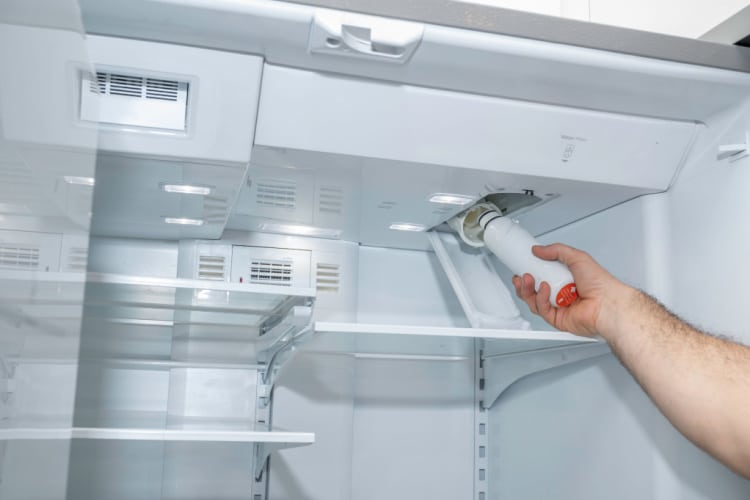Reverse osmosis to refrigerator connection is possible depending on the refrigerator type and RO system model.
However, we want to draw your attention to a few things you should keep in mind.
3 Things to Keep in Mind Before Making The Connection
1. Check for Compatibility
Some refrigerator companies will let you know if their products are not compatible with RO systems due to a difference in pressure. This is because for the water valve to operate as it should, the fridge has to be pressurized at a higher PSI (pounds per inch) than what RO systems are able to deliver on their own.
That being said, there is a workaround for this which involves using bypass plugs. However, we don’t encourage going this route and suggest that you always refer to your appliance’s manual and the manufacturer’s recommendations.
2. Purge the RO System
Before connecting an RO system to your fridge, you’d need to first purge the system. Purging the reverse osmosis system before connecting to a fridge is essential to prevent excess carbon from the system from clogging the fridge, especially if the fridge has a built-in water filter.
You’d may also need a filter bypass plug for some refrigerators. This will ensure that the system will work without clogging up. The plug you need will vary depending on the model of your refrigerator and the reverse osmosis system. Some refrigerators work seamlessly and don’t require bypass plug.
3. Pay Attention to the Water Line Distance (and the Pressure)
The way reverse osmosis works when connected to a fridge is; the water line is fed to the RO system, and then the filtered water line goes through a tube and into the refrigerator.
Running a long water line might end up disrupting the water pressure. So, it’s important to keep the water line between the water source (tap), RO system and refrigerator as short as possible.
How to Connect a Reverse Osmosis System to Refrigerator
Okay, we can finally start connecting the system to the fridge. Feel free to consult a professional if you’re not comfortable following these steps on your own.
- The first thing that you should do is shut off the cold water line that is feeding your RO system.
- Next, locate the tube that should extend from the RO system to the faucet. Remember to place a container under that tube in order to keep the surface beneath it dry.
- Cut the tube to required measurements. This all depends on where the tube comes out of your RO system, how long the tube is, and the space you have. The system will be able to drain the water straight into the container below through the tube.
- Once you’ve drained the water, install a tee fitting on one end of the cut tube, and connect the other end that goes to your faucet to the same fitting.
- After that, take a new tube and slot it into the tee fitting that runs perpendicular to the line to your faucet. The other end of this tube should run to the shut-off valve (found on top of your RO tank). The valve will regulate the water and the pressure coming from the filtration system and into your fridge.
- The valve should be turned off at all times and perpendicular to the tubing line. You can let the valve run only after the installation has been completed.
- The next step is running a tube from the other end of the valve into your fridge. Be mindful of the water pressure here—it has to match the levels that your fridge is capable of taking. Check the instruction manual of your fridge or reach out to the manufacturer for more information.
Once you’ve installed all the tubes properly, your RO-to-fridge connection should be working.
As an additional note, when changing your RO filters after this procedure, first shut off the inline valve, then flush the system.
Here’s a video explanation:
Fridge Filters vs Reverse Osmosis
If your fridge has a built-in water filtration system, the filter is most likely using carbon filtration technology. Carbon filters are very common in refrigerators with built-in ice and water dispensers.
Carbon filters use activated charcoal to absorb molecules of contaminants while allowing clean water to pass through. They’re excellent for getting rid of chlorine, but are not nearly as sophisticated as reverse osmosis systems.

Carbon filters won’t remove microbes, nitrates, and fluoride as efficiently as a dedicated reverse osmosis system. This makes the need for a full-fledged filtration system quite pressing for some homeowners.
Do You Need Both?
It depends on your needs. Fridge filters (carbon filters) are a decent alternative to reverse osmosis, but aren’t as effective as RO in removing contaminants. If you want basic water filtration in the fridge, then stick with the built-in filters. Otherwise, consider connecting an RO system to your fridge.
I have an R/O system installed and just bought a new LG fridge. Do i actually need to install a refrigerator water filter cartridge just to close the loop in the system? I assume yes as the fridge is designed to have the water flow through it before dispensing.
Wondering perhaps if there is just some sort of “plug” that I could put in its place rather then spending $50+ for a filter that will be useless ..thanks Scott!
Hi Frank, if your RO system is only for one point of use (such as under-sink or on-the-counter), then this fridge filter is another opportunity to ensure the water you consume is filtered. However, if you’re somehow feeding RO water into the fridge, some people still go with this “double” filtration or you can simply just not constantly replace the filter media in your fridge if you’re comfortable that your RO water is as good as you want it.